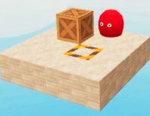What Is Sokoban?
Sokoban (倉庫番) is a Japanese word that translates to “warehouse keeper.” The game’s concept is exactly what the name suggests. You play as a warehouse worker whose job is to push boxes (or crates) onto designated storage locations, often marked by dots or colored tiles. Sounds simple, right? But as you play, you’ll quickly realize how complex it can get.
The game takes place in a confined space, usually a warehouse-style grid. The challenge comes from the rules of movement and the placement of obstacles. Once a box is pushed against a wall or into a corner, getting it out can be impossible. This makes each move critical and encourages players to think multiple steps ahead.
How to Play Sokoban
The rules of Sokoban are quite simple:
Objectives:
- Push all boxes (or crates) onto the target positions (goals).
- Complete the level using the fewest possible moves or in the shortest time.
Basic Rules:
- You can only push boxes, not pull them.
- You can only push one box at a time.
- You cannot push boxes through walls or other boxes.
- You can move in four directions: up, down, left, and right.
Controls (common in most digital versions):
- Arrow keys to move the character.
- Undo/Reset buttons are often available to backtrack or restart the level.
Winning a Level:
- A level is completed when every box is placed on a goal tile.
Losing:
- There is technically no “game over” in Sokoban, but a level can become unsolvable if boxes are pushed into corners or against walls where they cannot be retrieved.
The History of Sokoban
Sokoban was created in 1981 by Hiroyuki Imabayashi and published by Thinking Rabbit, a software company based in Japan. The game gained massive popularity for its simplicity and depth, eventually making its way to platforms like PC, Atari, and even mobile phones.
The concept of Sokoban influenced many other puzzle games that rely on spatial reasoning, such as Pushmo, Baba Is You, and many sliding block puzzles. Today, it’s common to find Sokoban clones, variations, and inspired levels in other puzzle-based games.
Variations and Modern Versions
Over the years, Sokoban has seen many adaptations and versions. Some popular variations include:
- 3D Sokoban: Adds a new dimension, literally, to the gameplay.
- Timed Sokoban: Where you must solve puzzles within a time limit.
- Multi-character Sokoban: You control multiple characters to solve puzzles cooperatively.
- Themed Sokoban: With different environments, from forests to factories, often with story elements.
You can play Sokoban on virtually any device: PC, smartphones, tablets, and even web browsers. There are also many free online platforms where users can create and share their own levels.
Tips and Strategies for Solving Sokoban Puzzles
Although Sokoban may appear simple, solving the puzzles can become highly complex. Here are some key strategies:
- 1. Avoid Corners
If a goal isn’t in a corner, never push a box into one—it will be stuck permanently.
- 2. Plan Ahead
Think several moves in advance. Sokoban is a game of foresight. Sometimes what looks like the best move can lead to a dead end later.
- 3. Work Backward
Try to imagine how a box needs to end up and work backward from the goal to its current location.
- 4. Undo Often
Use the undo function to experiment and explore options without restarting entirely.
- 5. Use Wall-Hugging
Stick to walls when moving boxes. This helps avoid blocking paths or limiting movement options.
- 6. Create Paths
Always leave yourself enough room to maneuver around boxes. If your character gets trapped, so does the puzzle.
- 7. Break It Down
Work on one section at a time. Some levels are easier to solve when broken into smaller goals.
Why Sokoban Is Still Relevant
Sokoban is often used as a benchmark in AI and programming challenges. It’s a perfect problem for testing decision trees, algorithms, and pathfinding logic. The seemingly simple mechanics result in a state space that grows exponentially, making it a favorite in computer science education.
Additionally, the minimalist design of Sokoban makes it accessible to all age groups. It doesn’t require fast reflexes, just a good brain workout. It’s a great game to improve logical thinking, spatial awareness, and patience.
Fun Facts About Sokoban
- The number of unique Sokoban levels is virtually infinite. Even small grids can have millions of possible configurations.
- Some of the hardest Sokoban puzzles have never been solved by humans—only AI.
- Sokoban is NP-hard, meaning that even powerful computers struggle with solving large puzzles efficiently.
- There are international Sokoban competitions where players solve increasingly complex puzzles in real-time.
Where to Play Sokoban
If you’re interested in trying the game out, here are some popular options:
- Online platforms: sokobanonline.com, xsokoban.com
- Mobile apps: Search “Sokoban” in the App Store or Google Play.
- PC Versions: Many open-source versions are available.
- Game Collections: Sokoban levels are often included in puzzle game packs on Steam or itch.io.
Final Thoughts
Sokoban is a masterclass in how elegant design and simple rules can create deep, rewarding gameplay. Whether you’re a casual gamer looking for a brain teaser or a hardcore strategist who enjoys breaking down complex puzzles, Sokoban has something for you.
It teaches patience, planning, and the importance of learning from mistakes. Each level solved is a small but satisfying victory, and each failure is a lesson in logic and reasoning. If you’ve never played Sokoban before, now is a great time to start. It’s a journey of boxes, brains, and brilliant satisfaction.

